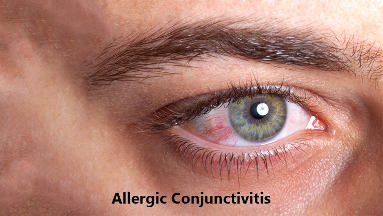Eye Irritation
Eye Irritation And How It Relates To Seasonal Allergies
Eye Irritation Overview
If you see someone suffering from allergies, you expect them to sneeze and have a runny or stuffy nose. That’s not always the case. Allergies are not only limited to the nose, but they also show their symptoms in the eyes. Swollen, itchy, and red eyes, followed by eye irritation, are often seen in people who are sensitive to some specific allergens. These allergens may be pollens from various plants due to the change in seasons resulting in seasonal allergies.
Other than pollens, some other allergens such as dander, dust mites, feathers, or food may cause eye irritation along with other symptoms. However, eye irritation related to seasonal allergies is specific due to an encounter with an outdoor allergen, particularly pollens from different types of trees, weeds, flowers, and spores in the air. Eye irritation caused due to seasonal change is also called Seasonal allergy conjunctivitis (SAC) and is the most common type of eye allergy.

Symptoms
Seasonal allergy symptoms are seen all year round, especially in spring, summer, and fall, depending on the type of pollen present in the air. Some typical symptoms of SAC are:
- Redness
- Itching
- Burning
- Watery eyes
- Swelling around the eyes
People with SAC may also notice dark circles (known as allergic shiners) under their eyes. Eyelids may get swollen and puffy that may be sensitive to sunlight. The signs of SAC frequently accompany runny nose, nasal sneezing, and congestion related to hay fever and other seasonal allergies.
The itching may be so alarming as the patients often rub their eyes to intensify symptoms and eventually contribute to infection.
Perennial allergic conjunctivitis (PAC) is an eye irritation that shows signs similar to those of SAC, but they are usually milder. They are caused by allergies to indoor allergens such as dust mites, mold, pet dander, or other household allergens instead of pollen.

Causes
When an outdoor allergen such as pollen gets intact with the body of a person who is sensitive to it, the body’s immune system overreacts, and antibodies attached to the mast cells of the eyes contacts with the allergen and respond by releasing histamine and other chemicals and substances that cause the minor blood vessels in the eyes to leak and eyes become itchy, watery and red.
Some of the common allergens that cause eye irritation due to seasonal allergies are:
- Birch pollen: This pollen is a common allergen in the spring and may cause eye irritation in people allergic to it.
- Oak pollen: Oaktree also send pollen in the air in spring
- Grass pollen: Grass pollen is common in the summer months.
- Ragweed pollen: Ragweed is the most common allergen among the weeds and is most active during the spring and fall season.
Managing Seasonal Allergy Eye Irritation
Individuals who know their allergens should try to keep themselves away from those allergens in those particular seasons. Avoid triggers by changing your routine and surrounding.
- Keep windows closed when the pollen content is higher during the spring and summer season. Try using an air conditioner at home and car.
- Wear sunglasses or protective glasses to avoid contact of pollens with eyes.
- Avoid going into fields, especially during spring and fall.
Treatment
Seasonal allergies can sometimes be unavoidable and cause various discomforts, but some minor symptoms can be treated at home:
- Apply some icepacks or cold compressors on your eyes to reduce swelling.
- Use lubricating eye drops or artificial tears: Artificial tears will wash allergens temporarily from the eye and moisturize it, which are frequently sore because they are red and irritated. These drops are used chilled to provide additional comfort and to calm, are effective, and can be used as much as possible.
- Avoid rubbing eyes that may cause mechanical loss of mast cells.
Some symptoms can be controlled by using over the counter medications such as:
- Decongestant eyedrops: Decongestive eye drops reduce the redness in eyes by eye blood vessels narrowing, minimizing the redness associated with eye irritation and seasonal allergies. They are available only with a decongestant or decongestant and an antihistamine that gives extra itching relief. Drops must be used regularly (4-6 times a day since their drops are weak). For red eyes, these drops should not be used for more than a week, or they can make things worse. Patients with glaucoma should avoid using it.
- Oral antihistamines: Oral antihistamines can be moderately helpful in eye allergy-related itching, but they may cause dry eyes and probably intensify the effects of eye allergy. Some over the counter variants of these drugs may also induce sedation, impulsiveness, dizziness, or problem with balance.
Medical Treatment
Prescription medication recommended by your allergist may be more effective that may contain;
- Antihistamine eyedrops: They can minimize the eye irritation symptoms that can cause redness, itching, and swelling. These drops provide quick relief, but its effects may last only a few hours, while some may be used four times daily.
- Mast cell stabilizer eyedrops: This inhibits the activation of histamine and other allergic effects substances. The drops must be used to avoid scratching until you are exposed to an allergy.
- Antihistamines and mast cell stabilizer eyedrops: Some new eyedrops have both an antihistamine and mast cell stabilizing agents to treat and prevent eye irritations. These, when used twice daily, can provide rapid, long-lasting release from itching, burning, and redness.
- Corticosteroid eyedrops: Corticosteroids are used in severe eye irritation symptoms. They can be used for two weeks without the doctor’s prescription but should have an ophthalmologist’s consent if a prolonged usage is desired. Continued use may cause glaucoma, cataracts, or infection.
- NSAID eyedrops: Non-steroidal anti-inflammatory medications are used to alleviate itching. When applied, these drops can cause sting or burning and must be used four times a day.
- Nonsedating oral antihistamines: Prescription antihistamine can be moderately effective in eye allergy relief. Since these drugs don’t have the same sedating side effects as OTC antihistamine, dry eyes and worsening symptoms may occur.
- Immunotherapy: Allergy shots or immunotherapy increase the immunity of a person to the allergic material. Dose changes are steadily injected in limited concentrations of the allergens over time. It takes you several months for the therapy to reach full benefits, and some medications will also be needed to relieve symptoms.
Conclusion
Seasonal Allergic Conjunctivitis is the eye irritation of hay fever and one of the most common eye complications. It is caused when an outdoor allergen reaches the eye surface and sets off an allergic reaction. It causes redness and swelling of the conjunctiva (the membrane covering the white of the eye) that can be treated with various over the counter and prescribed medications.
Written by: Madiha Ather Hashmi (November 16, 2020)
Sources
- Whitney Seltman (2019), “Understanding Eye Allergies”. WebMD. https://www.webmd.com/allergies/understanding-eye-allergies#:~:text=When%20you%20have%20allergies%2C%20your,red%2C%20teary%2C%20and%20itchy.
- Whitney Seltman (2019), “Learn More About Eye Allergies”. WebMD.
https://www.webmd.com/allergies/eye-allergies-1 - College of Optometrists (2019), “Seasonal Allergic Conjunctivitis (Hay Fever Conjunctivitis); Perennial Allergic Conjunctivitis”. College of Optometrists.
https://www.college-optometrists.org/guidance/clinical-management-guidelines/seasonal-allergic-conjunctivitis.html#:~:text=Seasonal%20Allergic%20Conjunctivitis%20(SAC)%20is,Allergens%20are%20usually%20airborne.
Medically Reviewed By

Alexandria University Hospital
I have reviewed the articles on seasonalallergies.org and I would like to say that I was very surprised.
Over years, I have seen many different articles in the field of allergy, but these articles were very interesting.
These articles were really unique, they could help many people around the world to know more about seasonal allergy, symptoms, prevention and when to seek medical advice.
These articles represent an addition in the field of Health Education not only for people with allergy but also for the whole population.
Last Updated on July 5, 2023